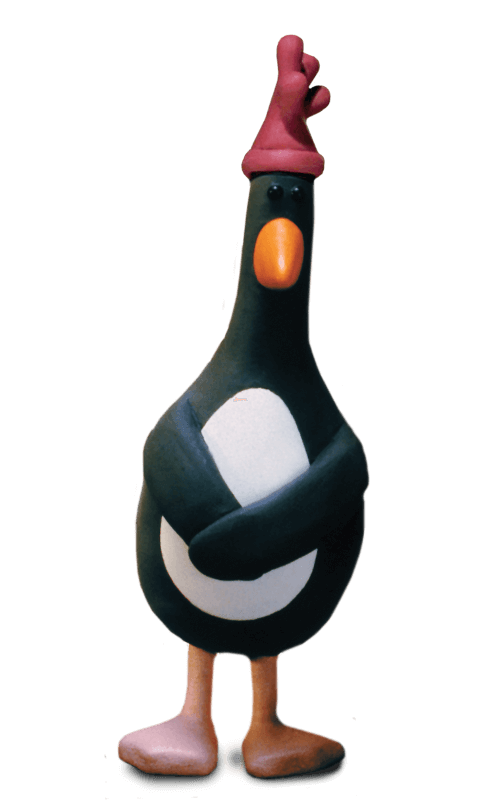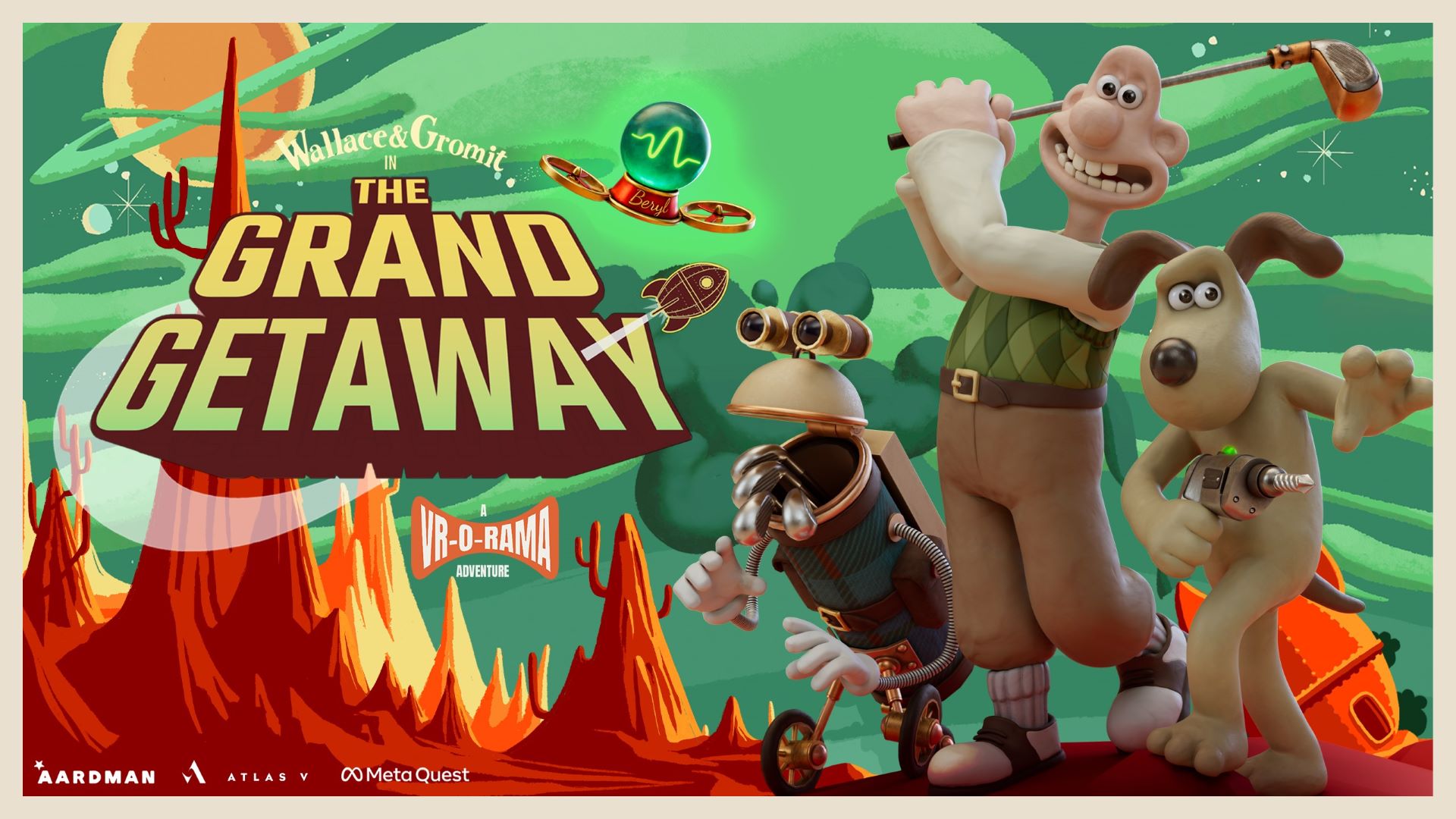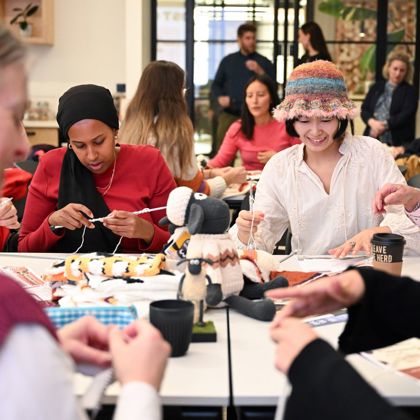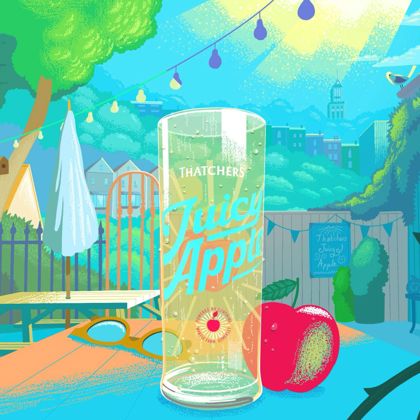'The Grand Getaway’ is the very first VR-O-Rama adventure featuring the much-loved duo Wallace & Gromit. Having told stories with these characters in many forms over the years, Aardman was delighted to get the opportunity to take them into Virtual Reality (VR) and finally give people the chance to step into their world in a new and immersive way.
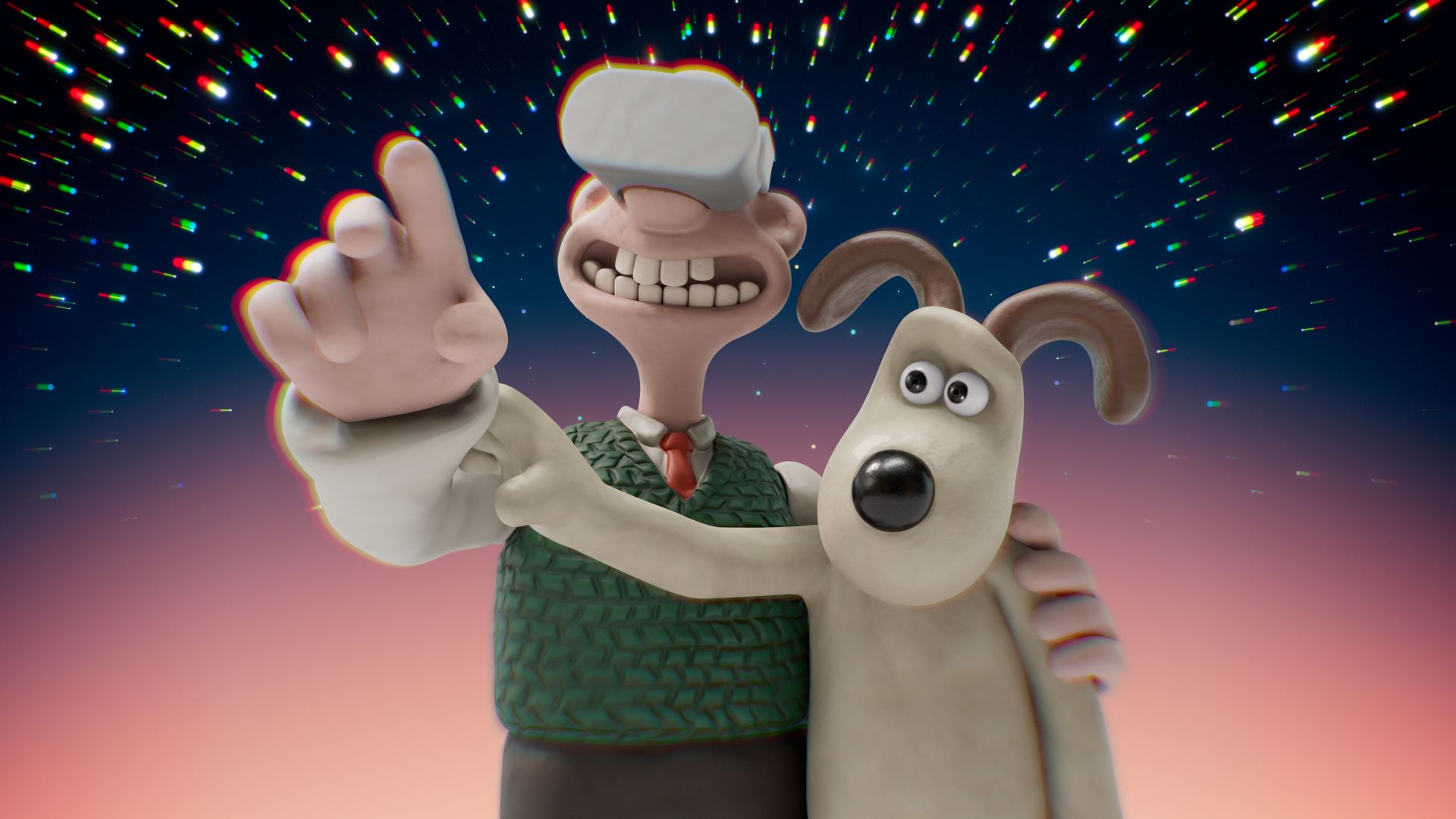
Origin
The origins of the project began with a non-Aardman piece called ‘Madrid Noir.’ This was an Emmy award winning interactive VR adventure by London-based immersive story studio No Ghost and French publisher Atlas V. It uses animation and light interactions to tell the story of Lola – a little girl engaged in solving a noirish mystery in 1930s Madrid. The success of this project, and an existing relationship with Meta, led them to seek a bigger known family-friendly brand to bring on board as the basis for their next collaboration. The hope being to widen the appeal and accessibility of Virtual Reality more broadly.
They approached Aardman with some rough early ideas for an adventure involving Wallace & Gromit and worked with Merlin Crossingham (Creative Director for Wallace & Gromit) and Finbar Hawkins (Writer and Director of Wallace & Gromit’s Augmented Reality adventure ‘The Big Fix Up’) to nail a more specific concept around which to pitch and build the experience. The result of that early thinking was an idea that would bring back the iconic rocket from A Grand Day Out (Wallace & Gromit’s very first adventure) and send the duo on a mission to Mars. It was a concept that felt like it would allow for plenty of callbacks and wish fulfilment moments for existing fans, but also make the best of the medium by sending you somewhere with the potential for fun, humour, character and scale in a way that would appeal to new audiences too.
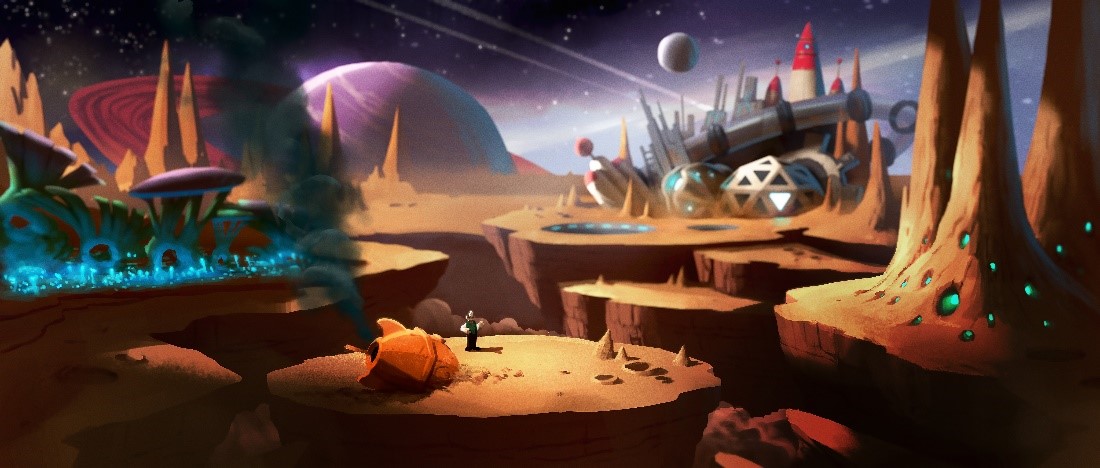
An early piece of concept art by Jim Grant on the theme of ‘crash landing on Mars’
The project was greenlit, and our own adventurous mission began. We had to put together the team AND create a ‘Vertical Slice’ – a fast turnaround but polished full 5-minute taster of the entire experience. All whilst still working out the scope and detail of the whole piece, i.e. how to take that topline idea and work out the practical and production details of extending it to a full 1 to 2-hour experience.
Story
Of course, the core of everything is story, so we started with a writer's room to explore several ideas building on that topline premise. Nick Park brought some script ideas and character sketches he’d been chewing over in previous years involving an ‘Auto-Caddy’ golfing contraption Wallace might invent to help him play golf. That, paired with some ideas from the room about golf ball-like alien eggs which the pair could discover on Mars, unlocked everything that became the core of the narrative for the adventure. A golfing holiday gone wrong - with the big conceit being that Wallace doesn’t realise and obliviously explores Mars assuming it’s Bognor Regis, whilst Gromit tries to put things right to get them home. All with some otherworldly gags and distractions along the way...
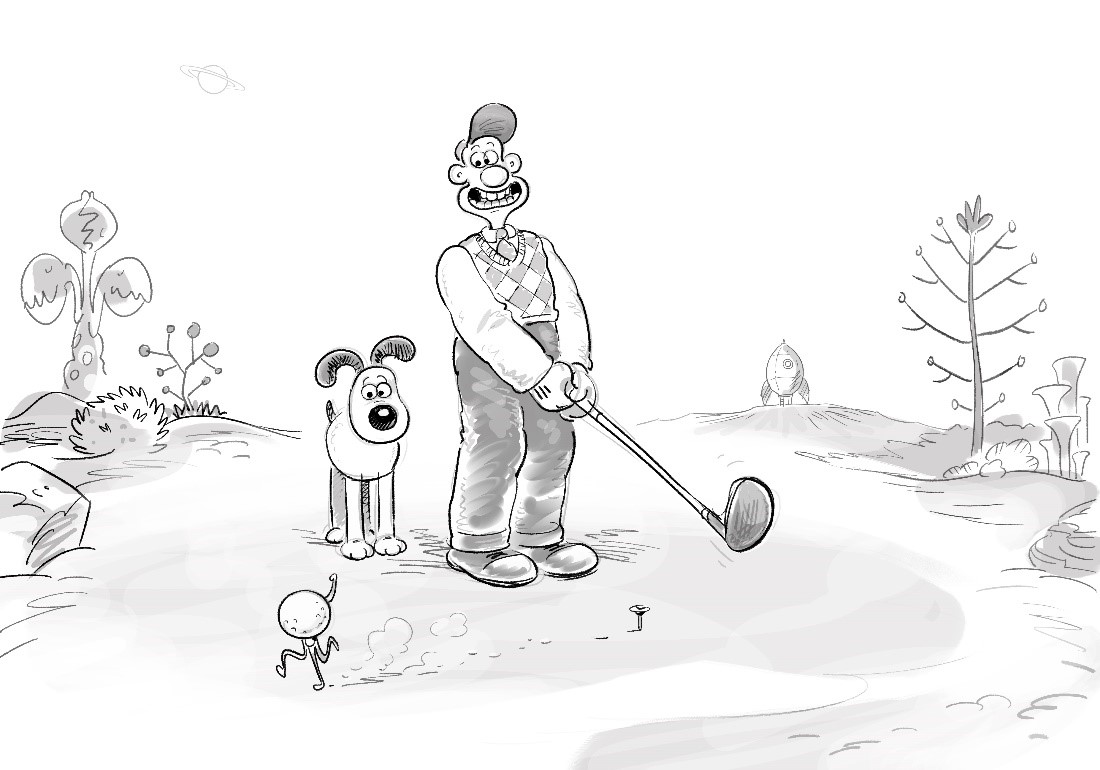
Early concept art from Dave Vinicombe trying to capture the spirit of the adventure
However, whilst that felt like fertile territory for storytelling, VR brings the challenge of ‘story doing’ too. Unlike a film where you sit back and watch a linear experience play out, VR gives you agency and presence in a fully immersive 360-degree interactive world. You are part of that narrative, participating in it. That means we had to work out who YOU were in all of this as well.
Character
Our initial assumption was that, given it is a Wallace & Gromit adventure, you need to play as Wallace or Gromit at some point. Gromit turned out to be a good fit as it allowed for a characterful and story-appropriate way of doing various bits of repairing and tidying up after Wallace (as well as frequent eye rolling at his misunderstandings). However, we knew that if you were Gromit throughout, you would never actually get to SEE him which would be disappointing. On the other hand, if you were to be Wallace throughout, we feared a disconnect between the knowledge you might carry as the audience and the ‘haplessness’ required of Wallace...and of course Gromit doesn’t talk so couldn’t easily guide you to set things right. That might lead to fun moments of silly play, but he could not be your only route into the adventure. Even a set-up where you switched between both still left a fundamental problem – you would never get to simply see the two of them together.
That is where Auto-Caddy came in yet again. Not just as a characterful story touch for a golfing holiday, but as a logical way for the player to inhabit something with fun gamified 'powers’ AND the ability to see the pair together. When we landed on the story idea that he had an additional part to play in the narrative, through his bond with the golf ball-like aliens, everything slotted into place. We had the framework for a 12-chapter adventure which would take you to Mars and back, in which you automatically transitioned between three key characters to play through each section from the perspective that we felt was best tailored to the gameplay and the narrative beats we wanted you to experience at that point.
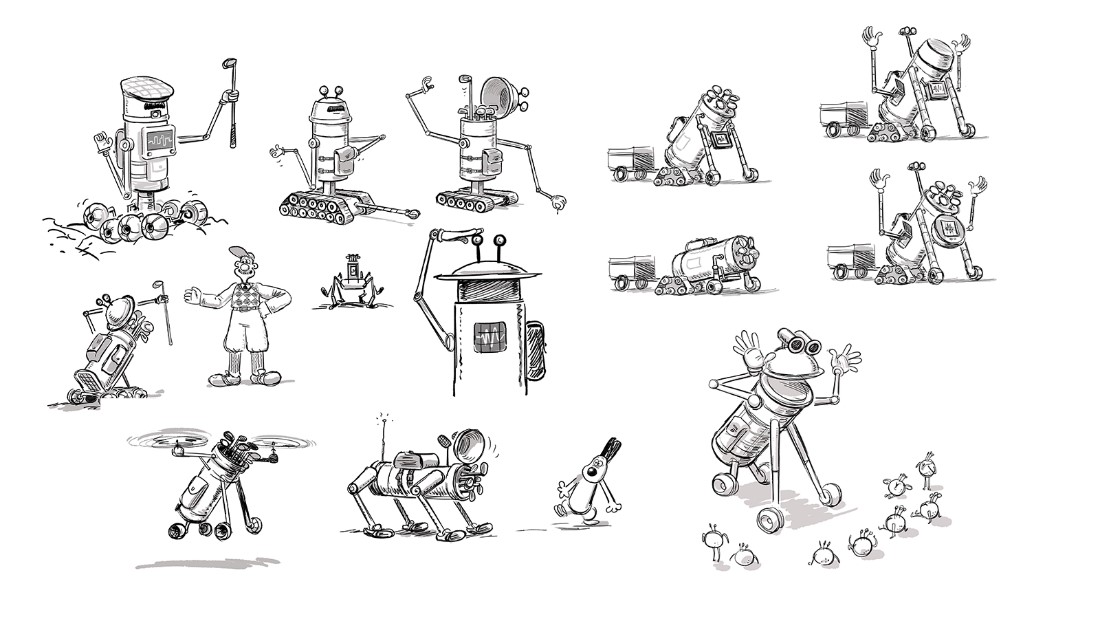
Some early explorations for different Auto-Caddy designs by Dave Vinicombe
However, we were aware that this framework – and the whole experience of VR – might need some additional explanation to help people through. Particularly given that we hoped that The Grand Getaway might be one of the experiences that could tempt a total newcomer to try a headset for the first time. Again, the issue of Wallace’s idiocy and Gromit not speaking emerged, and so we decided to bring back the character of ‘BERYL’ from The Big Fix Up (voiced by the marvellous Miriam Margolyes) to help. To again act as a story-appropriate and characterful way of solving a practical problem – in this case providing a voice that could explain things and chivvy you along as an in-world guide.
Production
With this core set of principles established, we then progressed with all the usual fun of a production. As a priority, Finbar created a full script and worked with Co-Director Bram Ttwheam and a host of concept artists and storyboard experts to visualise how some of this might look.
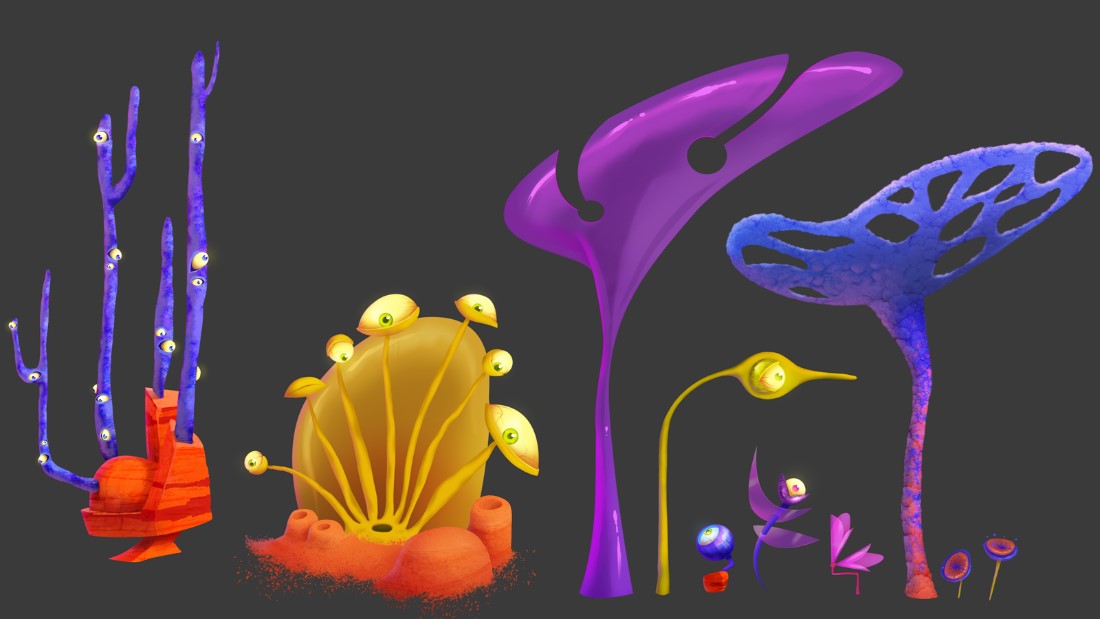
Early explorations for the flora & fauna of Mars by Amy Lewis
CG modelling
These became references for the wonderful CG modellers we had on the project, which included the core character team at Aardman who were able to work with our in-house riggers and the technical experts at No Ghost to tailor everything for use in the Unreal game engine that powers the experience. This meant working to create CG models with as much of the quality and aesthetic of the real thing whilst still being optimised to be workable and performant in VR. That’s because whilst Meta Quest headsets are fantastic pieces of hardware, they are still effectively mobile technology. Everything has to render in real time in the headset – they’re not ‘prerendered’ on big server racks as with a CG film. It means everything is a balance between aesthetics and meeting strict technical limitations and requirements. We worked hard with the team at No Ghost to find solutions that would let us keep that sense of tactility and physicality you would expect from the films but made sure that the underlying skeleton rigs and textures were ‘light’ enough to be effectively brought to life and perform well in the game.

Renders of some of our core cast of characters modelled by the in-house CG team
Animation
Models created, we needed to bring them to life! With Finbar’s script we were able to translate scenes of action and dialogue into a detailed animation database – a list of actions that needed creating for each character. However, unlike a traditional film we had the additional challenge of considering what characters are doing in a scene when they’re not part of the core action, as unless they’ve left, the audience can still see them. That meant having to work out not just core actions but also ‘inactions’ - what characters did when they were not doing something specific in a particular part of a story. That meant an enormous amount of extra work for our talented animators to create a bank of generic and idling actions that characters could move between to stay active and alive for as long as it took the audience member to do the thing that progressed the core story.
Thankfully we had an incredible team, including people who had worked on live action stop motion for Aardman. They did a wonderful amount of work to bring the characters to life and mimic the stop motion style of the films. Even though the headset runs at 72 frames per second, we took a ‘stepped’ approach and had them animate on 2s, i.e. each beat of the action is held for two frames rather than one. That gave the staccato stop motion feel we wanted. We’d create simple block throughs of key scenes, put them in engine, then do lots of iterations and experimentation to make sure actions and eyelines worked in the (virtual) ‘physical’ sets and built up our animations from there.
Audio
As part of that process, audio took additional importance to both add immersion and help direct attention in a world where the player is free to effectively look anywhere. Ben Whitehead (as Wallace) and Miriam Margolyes (as BERYL) provided an incredible amount of dialogue – including accounting for variations to cover all kinds of user journeys through the adventure – and Michael Csányi Wills worked to early versions of scenes to create some amazing music to enhance scenes and score key moments of emotion.
These were all pipelined through to No Ghost who had their own ingestion process to get everything in-engine and provided regular builds for us to review and comment on. We also had the team at VR studio Albyon doing additional scenery modelling and all the core sound design to feed into this wider effort across multiple companies – all coming together to tell this epic story.

Ben Whitehead in a voice booth recording lines as ‘Wallace’
Challenges
The work and love poured into this by everyone was truly above and beyond, sparked by everyone's desire to do right by these characters and satisfy the fans in all of us. Besides the usual production challenges of resource and time, the main recurring challenge in VR was about being less able to rely on pre-production and planning. We could have ideas, but even more than a film, it is in the coming together of these disparate elements in context where you know if things are working or not.
That meant a lot of cycles of creating, testing, and iterating. Thinking in (virtual) physical space is almost like a theatre director trying to choreograph attention from the perspective of the audience being somewhere rather than just watching something. Thankfully, various bits of greybox prototyping and VR specific tools like Gravity Sketch made it easy for people to virtually meet in a space where things could be modelled, annotated and discussed.
As Aardman, our job in all of this was to help steer the ship and keep everything on vision. To constantly take the perspective of the audience and ask ourselves whether the narrative and the world had the heart and humour you would expect from Wallace & Gromit, with No Ghost supporting to design interactions and gameplay that complimented that. At many moments it felt very much like the iconic chase sequence from The Wrong Trousers, with Gromit creating the train track from the train. Having to keep moving towards a looming deadline and reacting in response to how things came together. And, of course, taking the advantage of a fully 360 world to use every spare moment we had to load scenes with the extra gags and easter eggs that, just like with the films, we hope people will take the timeto re-watch, re-play and discover.
Release
We are delighted to have been able to release the final adventure to the world and see such a warm response – particularly from fans who seem to have understood that even through the experimentation and ‘newness’ of the medium, the heart and humour you would expect from those characters and that world is shining through.
To come off the back of ‘The Big Fix Up’ Augmented Reality project that brought Wallace & Gromit into our world, to The Grand Getaway that lets us go into theirs, was a dream come true. It was also a fantastic opportunity to do what the Interactive team at Aardman loves best – to collaborate with great people, and use technology to create worlds and tell stories.
Watch the case study video here:
Related content
GET IN TOUCH
